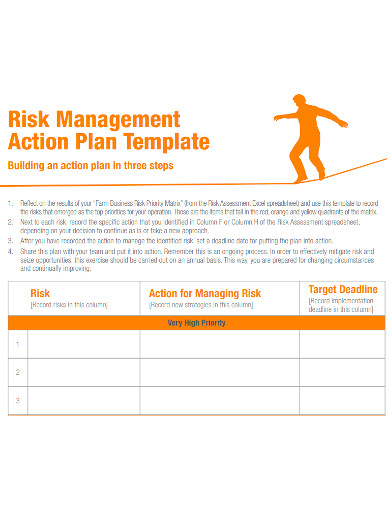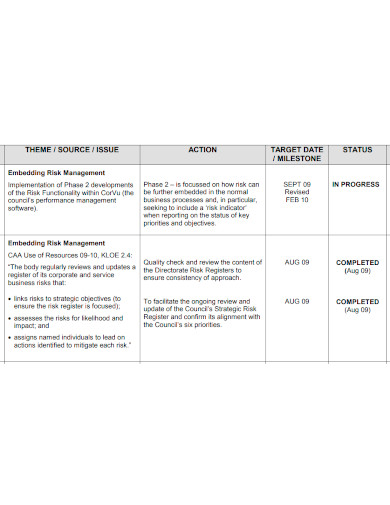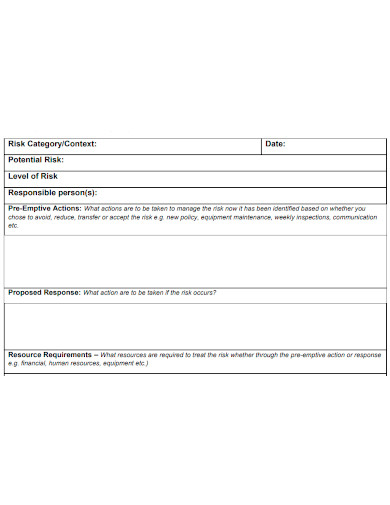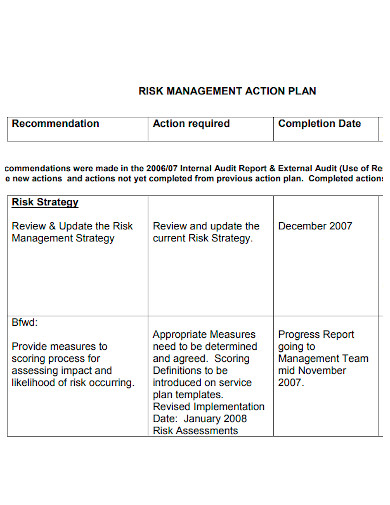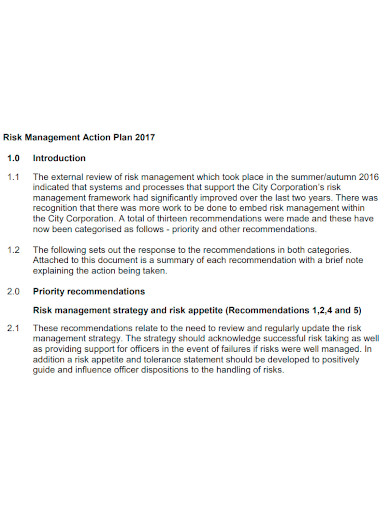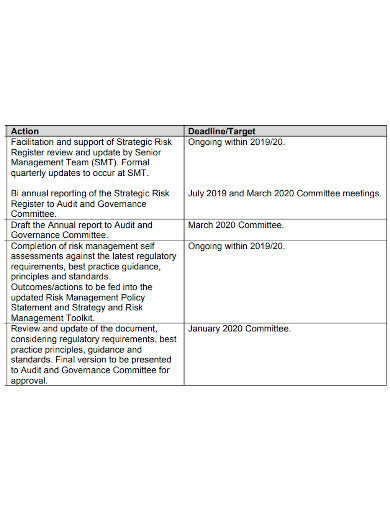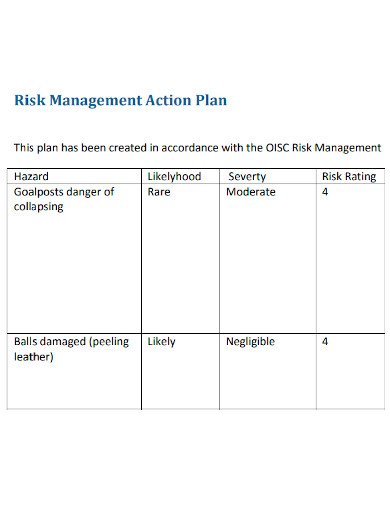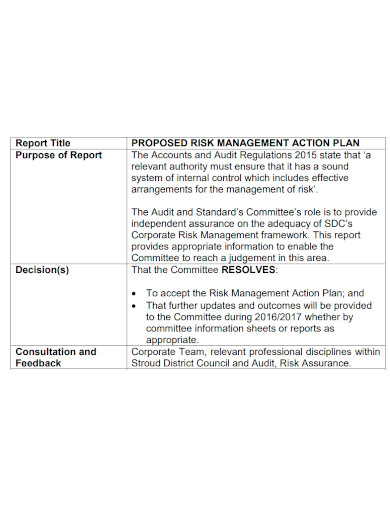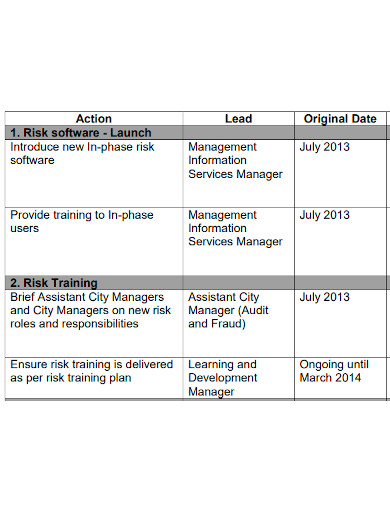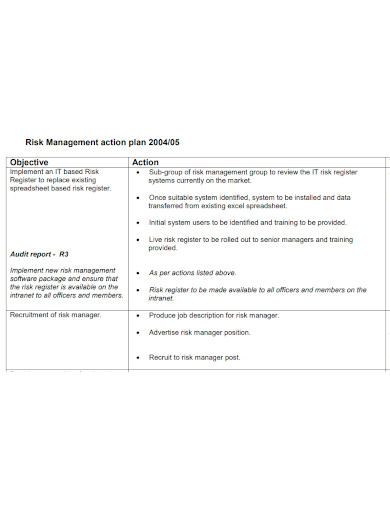10+ Risk Management Action Plan Samples
“Failure to plan is planning to fail.” This was a principle founded in Sun Tzu’s The Art of War. In our lifetime, we go through various disasters— regardless whether it’s natural or man-made. With this in mind, it’s imperative to plan. The same can be said for organizations and firms alike. Every business and organization faces the possibility of unfortunate events, damaging occurrences that could cost them money or force them to close permanently. The capacity to manage risk will enable businesses to make more confident business decisions in the future. In this article, we provide free, ready-made, and editable samples of Risk Management Action Plans that you could use. Keep on reading to find out more!
1. Risk Management Action Plan Sample

2. Standard Risk Management Action Plan
3. Risk Management Action Plan Format
4. Formal Risk Management Action Plan
5. Printable Risk Management Action Plan
6. Editable Risk Management Action Plan
7. General Risk Management Action Plan
8. Strategic Risk Management Action Plan
9. Basic Risk Management Action Plan
10. Professional Risk Management Action Plan
11. Risk Management Group Action Plan
What Is a Risk Management Action Plan?
Risk management is the process of identifying, analyzing, and responding to risk factors that arise over the course of a company’s operations. Effective risk management entails aiming to influence future events as much as possible by acting proactively rather than reactively. That said, a Risk Management Action Plan is the plan of action that an organization commits to take to handle potential risks, lower the possibility of them occurring, and mitigate the consequences of these risks if they do occur. A strategy is devised to guarantee that the appropriate steps are taken in a timely way.
Put simply, a Risk Management Action Plan are the contingency plans set in place to prepare for the unanticipated. This ensures the coordination between all teams in the firm as they would know what their roles would be before, during, and after a crisis.
How to Make a Risk Management Plan
There are various types of Risk Management Action Plans, such as: (1) plans that comprise procedures aimed at totally avoiding the hazards at hand by preventing them from occurring in the first place, and (2) plans that involve strategies to lower the possibility of a risk occurring or to mitigate the consequences of a risk if it does.
Aside from the variety of Risk Management Action Plan templates that are provided above, you can also make one of your own from scratch. If you’re interested in making an action plan that is specifically catered to your organization/firm, here are some key components that could guide you:
1. Identifying existing threats and potential risks
The process of identifying risks primarily include brainstorming. A company must gather its workforce so that they can go over all of the potential sources of risk. Prioritization is also crucial as it ensures that those that can have a substantial impact on an organization are dealt with first. After all, it is impossible to manage all current risks.
2. Determine the roots of crisis
The process of problem resolution is first recognizing the issue and then determining an acceptable remedy. However, before determining how to best manage risks, a company should determine the source of the risks by analyzing what could be the potential causes of a crisis and the gravity of the impact in the business.
3. Establish the appropriate responses for the specific crisis
When a company decides to analyze potential remedies to minimize recognized risks and prevent recurrence, it must first see steps that can be made to ensure that the identified risk does not recur and furthermore what the necessary actions are needed if it happens again.
4. Initiate preventive measures
With all these components in mind, you will be able to initiate preventive measures in order to avoid such crisis situations. Prevention, after all, is better than cure. Check out these examples of our free preventive action plan checklists here.
FAQ
Why is risk management important to a business?
Risk management is critical in an organization because it allows a company to establish its long-term goals. The capacity to manage risk will enable businesses to make more confident business decisions in the future.
What are examples of risk management methods?
Risk management’s main principles—avoidance, retention, sharing, transferring, and loss prevention and reduction—may be applied to all aspects of a person’s life and can pay off in the long term.
What should a risk control action plan include?
A risk management action plan must have specifics in order to be effective. Identifying risks in advance, understanding how risks would effect a project, prospective risk planning, and risk monitoring are some of the aspects.
All in all, in order to minimize repercussions and disruptions that could greatly affect your firm, you need to prepare and plan. Download our free, ready-made, and printable samples of Risk Management Action Plans that could greatly help your company!
Related Posts
FREE 16+ Sample Change Management Plan Templates
FREE 15+ Sample Project Management Plan Templates
FREE 10+ Investment Risk Management Samples
FREE 10+ Restaurant Action Plan Samples
FREE 10+ Environmental Management Plan Samples
FREE 9+ Sample Risk Management Plan Templates
FREE 8+ Sample Behavior Management Plan Templates
FREE Critical Skills Every Project Managers
FREE 10+ Safety Management Plan Samples
FREE 13+ Credit Risk Management Samples
FREE 11+ Risk Management Strategy Samples
FREE 9+ Human Resources Management Plan Samples
FREE 8+ Property Risk Management Samples
FREE 6+ Risk Plan Samples
FREE 6+ Inventory Risk Management Samples

